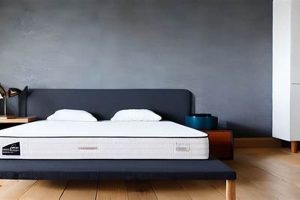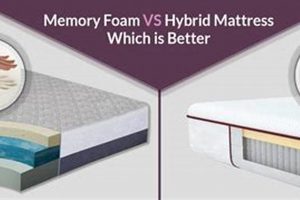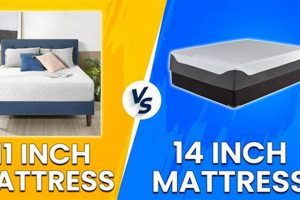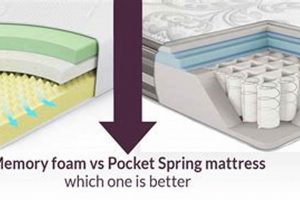The selection of a sleep surface often involves choosing between two primary interior constructions: those employing manufactured polymers and those utilizing coiled metal. These two categories represent fundamentally different approaches to providing support and comfort for the human body during rest. The former typically offers conforming support, while the latter aims to deliver resilience and bounce.
The importance of selecting an appropriate sleep surface lies in its direct impact on sleep quality, and consequently, on overall health and well-being. Historically, coiled metal construction dominated the market. However, advancements in material science have led to the widespread adoption of polymer-based alternatives. The advantages and disadvantages of each construction type are often debated within the consumer market, with individual preferences and specific physical needs influencing the final decision.
This article will delve into the characteristics, benefits, and drawbacks of each type of construction. Examination of the material composition, support mechanisms, durability, and cost considerations for each category will follow. This detailed analysis will aid in understanding the key differentiators and assist in making an informed purchasing decision.
This section provides concise guidelines for evaluating different mattress construction types, focusing on key considerations for informed decision-making.
Tip 1: Assess Support Needs. Individuals with specific musculoskeletal conditions should prioritize appropriate spinal alignment and pressure relief. Different construction types offer varying levels of these benefits, which must be tailored to individual requirements.
Tip 2: Consider Sleeping Position. Side sleepers generally benefit from enhanced contouring. Back sleepers often require firmer support. Understanding the implications of sleeping posture is essential for selecting the appropriate support system.
Tip 3: Evaluate Temperature Regulation. Some materials exhibit greater thermal retention than others. Individuals prone to overheating during sleep should investigate options with enhanced breathability and cooling properties.
Tip 4: Examine Motion Isolation. If sharing a bed, motion isolation capabilities minimize partner disturbance. Certain construction types are designed to dampen movement transfer, leading to more restful sleep for both individuals.
Tip 5: Review Durability Expectations. The lifespan of sleep surfaces varies based on material composition and construction. Researching the average lifespan of different types provides valuable insight into long-term value.
Tip 6: Compare Cost-Effectiveness. Price points differ substantially between various mattress constructions. Evaluating initial cost against anticipated lifespan and performance characteristics determines the most cost-effective option.
Tip 7: Inquire About Trial Periods. Many manufacturers offer in-home trial periods. This allows individuals to experience the sleep surface firsthand and assess its suitability before committing to a purchase.
By considering these factors, consumers can navigate the complexities of mattress selection and identify a sleep surface that aligns with their individual needs and preferences. This leads to improved sleep quality and enhanced overall well-being.
The subsequent section will offer a comprehensive conclusion that summarizes key points and reinforces the importance of making an informed decision.
1. Support and Alignment
Proper spinal support and alignment are paramount for restful sleep and long-term musculoskeletal health. The design and materials employed in mattress construction directly influence the degree to which a sleep surface can maintain neutral spinal posture, a critical factor differentiating foam and spring mattresses.
- Conforming Support in Foam Mattresses
Foam mattresses, particularly those utilizing memory foam or latex, excel in conforming to the body’s contours. This characteristic allows for even weight distribution and reduces pressure points, promoting natural spinal alignment, especially for side sleepers. The enveloping nature of the foam fills gaps between the body and the mattress, providing consistent support.
- Resilient Support in Spring Mattresses
Spring mattresses, incorporating coils or innersprings, primarily offer support through resistance. The firmness and arrangement of the coils determine the level of support provided. Hybrid mattresses often combine springs with foam layers to balance the resilient support of the springs with the conforming properties of foam, seeking to optimize spinal alignment for a broader range of sleepers.
- Impact of Firmness on Alignment
Mattress firmness plays a crucial role in alignment. A mattress that is too soft may lead to excessive sinking, resulting in spinal misalignment. Conversely, a mattress that is too firm may create pressure points and prevent proper contouring. The ideal firmness level is subjective and dependent on individual body weight, sleeping position, and personal preference, regardless of whether the construction is foam or spring based.
- Long-Term Effects on Posture
Consistent use of a mattress that does not adequately support the spine can contribute to chronic back pain and postural problems. Selecting a mattress that properly aligns the spine in its natural curvature is an investment in long-term health. Both foam and spring mattresses, when properly chosen, can effectively maintain spinal alignment and mitigate the risk of musculoskeletal issues.
The effectiveness of both foam and spring mattresses in providing adequate support and alignment hinges on selecting the appropriate firmness level and construction type to accommodate individual needs. It is essential to consider factors such as sleeping position, body weight, and any pre-existing spinal conditions when making a purchasing decision. Trial periods, when available, offer a valuable opportunity to assess the suitability of a mattress firsthand.
2. Pressure Point Relief
Pressure point relief is a critical factor in determining sleep comfort and quality. The capacity of a sleep surface to minimize pressure concentration on bony prominences and joints directly influences circulation, reduces tossing and turning, and promotes deeper, more restorative sleep. Different mattress constructions offer varying degrees of pressure relief, impacting the overall sleep experience.
- Conforming Properties of Foam
Foam, particularly memory foam and latex, excels at pressure point relief due to its ability to conform to the body’s shape. This conforming characteristic distributes weight evenly across the mattress surface, reducing pressure concentration on areas such as the shoulders, hips, and knees. Memory foam achieves this through its viscoelastic properties, while latex provides a more responsive and buoyant conforming feel. This is particularly beneficial for side sleepers who experience higher pressure on specific areas.
- Coil Systems and Pressure Distribution
Spring mattresses, while offering support, traditionally provide less targeted pressure relief than foam. The individual coils provide resistance, but the surface may not contour as closely to the body’s curves. However, advancements in spring mattress technology, such as pocketed coils and zoned support systems, aim to improve pressure distribution. Pocketed coils move independently, allowing for more localized conforming, while zoned systems vary coil firmness across the mattress to target specific areas of the body.
- Material Density and Firmness Impact
The density of foam and the firmness of coil systems significantly affect pressure relief. Higher density foam provides greater support and durability, but may also feel firmer, impacting its conforming ability. Softer coil systems offer greater initial comfort but may lack adequate support for heavier individuals. The ideal balance between support and pressure relief is subjective and depends on individual body weight, sleeping position, and comfort preferences.
- Hybrid Designs for Enhanced Relief
Hybrid mattresses, combining the features of both foam and spring constructions, often attempt to optimize pressure point relief. These mattresses typically feature a coil support core with a comfort layer of foam on top. The coil system provides support and responsiveness, while the foam layer offers contouring and pressure relief. The effectiveness of a hybrid mattress in relieving pressure depends on the quality and thickness of the foam layer, as well as the design of the coil system.
The effectiveness of either a foam or spring mattress in alleviating pressure points ultimately depends on the specific design and materials used, as well as individual needs and preferences. Considering factors such as sleeping position, body weight, and desired level of firmness is essential when selecting a mattress that effectively minimizes pressure concentration and promotes restful sleep.
3. Motion Isolation
Motion isolation, the capacity of a mattress to minimize the transfer of movement across its surface, constitutes a significant differentiator between foam and spring mattress constructions. This characteristic directly impacts sleep quality, particularly for individuals sharing a bed. The degree to which a mattress isolates motion determines the extent to which one partner’s movements disturb the other’s sleep.
Foam mattresses, specifically those incorporating memory foam or latex, generally excel in motion isolation due to their inherent damping properties. These materials absorb movement energy rather than transmitting it across the mattress surface. A common example involves one partner getting in or out of bed while the other remains largely undisturbed, owing to the foam’s ability to isolate the associated movements. In contrast, traditional innerspring mattresses tend to exhibit greater motion transfer. The interconnected coil system can propagate movement throughout the mattress, potentially disrupting a sleeping partner. However, advancements in spring mattress design, such as individually pocketed coils, mitigate this effect by allowing each coil to move independently.
The practical significance of motion isolation is evident in scenarios involving individuals with different sleep schedules or those prone to restlessness. A mattress with effective motion isolation can minimize sleep disruptions and improve overall sleep quality for both partners. While spring mattresses have improved in this area, foam constructions often remain the preferred choice for individuals prioritizing minimal motion transfer. Choosing between foam and spring therefore necessitates a careful evaluation of motion isolation properties in relation to individual needs and co-sleeping arrangements.
4. Temperature Regulation
Temperature regulation plays a crucial role in maintaining sleep comfort, and the construction of a mattress significantly influences its ability to dissipate heat and manage moisture. The inherent properties of materials used in foam and spring mattresses dictate their respective thermal performance characteristics. Consequently, the choice between these mattress types necessitates careful consideration of individual thermoregulatory needs.
Foam mattresses, particularly those constructed from traditional memory foam, tend to retain heat due to the material’s dense structure and limited airflow. This can result in elevated body temperatures and discomfort for individuals prone to overheating during sleep. Manufacturers have addressed this issue by incorporating features such as open-cell foam structures, gel infusions, and phase-change materials designed to enhance breathability and dissipate heat. Spring mattresses, on the other hand, generally offer better airflow due to the open space within the coil system. This allows for greater heat dissipation and can contribute to a cooler sleep environment. Hybrid mattresses, which combine foam and spring components, aim to strike a balance between comfort and temperature regulation, but their thermal performance depends heavily on the specific materials and construction techniques employed. For instance, a hybrid mattress with a thick layer of dense memory foam may still exhibit significant heat retention, even with a spring support core.
In summary, temperature regulation is a critical consideration when selecting a mattress. While spring mattresses generally offer better airflow, advancements in foam technology have led to the development of more breathable and temperature-regulating foam options. The choice between foam and spring should be based on individual thermal preferences, with careful attention paid to the specific materials and construction techniques used in each mattress type. Failing to account for these factors can lead to discomfort and disrupted sleep.
5. Durability and Longevity
The durability and longevity of a mattress represent crucial factors influencing its long-term value proposition. The construction type, specifically when considering foam versus spring options, directly affects the lifespan and sustained performance of the sleep surface. Material degradation, structural fatigue, and loss of support contribute to the eventual decline in mattress performance. Spring mattresses are susceptible to coil fatigue, where the springs lose their resilience over time, leading to sagging and uneven support. High-quality coil systems and greater coil density can mitigate this issue, extending the mattress’s lifespan. For example, a mattress utilizing a high-gauge, tempered steel coil system is expected to exhibit greater longevity compared to a mattress with thinner, less durable coils.
Foam mattresses, conversely, are subject to compression and material breakdown. Lower-density foams tend to compress more rapidly, resulting in a loss of support and the formation of body impressions. Higher-density foams, such as those found in quality memory foam or latex mattresses, exhibit greater resistance to compression and maintain their structural integrity for a longer period. The thickness of the foam layers also plays a significant role; thicker layers generally provide more cushioning and resistance to wear. Consider a memory foam mattress with a density of 5 pounds per cubic foot compared to one with a density of 3 pounds per cubic foot. The higher-density option will typically demonstrate superior durability and resistance to compression over time, translating to a longer lifespan.
Ultimately, the durability and longevity of both foam and spring mattresses are contingent on the quality of materials and construction techniques employed. Regular rotation of the mattress can help to distribute wear more evenly, extending its lifespan. Choosing a mattress from a reputable manufacturer that utilizes high-quality materials and robust construction methods is a key factor in ensuring long-term performance. The selection process should include careful evaluation of material specifications, coil gauge (for spring mattresses), foam density (for foam mattresses), and warranty terms to make an informed decision aligned with expectations for durability and sustained comfort. Addressing these factors appropriately ensures cost-effectiveness and reduces the frequency of mattress replacement.
6. Cost Considerations
The financial aspect constitutes a significant determinant in the selection of a sleep surface. The comparative expense of foam and spring mattresses varies considerably based on materials, construction complexity, brand reputation, and included features. A comprehensive assessment of cost should extend beyond the initial purchase price to encompass long-term value, including durability, potential maintenance, and expected lifespan.
- Initial Purchase Price Disparities
Entry-level spring mattresses often present a lower initial cost compared to their foam counterparts. The simplicity of basic innerspring construction allows for economies of scale in manufacturing. Conversely, specialized foam formulations, such as memory foam or latex, and the associated manufacturing processes can elevate production costs, leading to a higher retail price. This price differential may influence budget-conscious consumers toward spring options, at least initially.
- Material Composition and Pricing
The type and quality of materials directly influence mattress pricing. Higher-density foams, organic latex, and advanced coil systems contribute to increased manufacturing costs. Spring mattresses incorporating individually pocketed coils, reinforced edge support, and multiple comfort layers will generally command a higher price than basic innerspring models. Similarly, foam mattresses utilizing gel infusions, open-cell structures, or plant-based foams will typically be more expensive than standard polyurethane foam mattresses. These material variations underscore the importance of comparing specifications and understanding the cost implications of specific features.
- Long-Term Value and Replacement Costs
While initial purchase price is a primary consideration, long-term value and potential replacement costs are equally important. Mattresses with greater durability and resistance to wear offer a lower cost per year of use. Spring mattresses may require replacement sooner if coil fatigue leads to sagging or uneven support. Foam mattresses, particularly those constructed from lower-density materials, are susceptible to compression and may lose their conforming properties over time. Assessing expected lifespan and warranty coverage is crucial in determining the overall cost-effectiveness of each mattress type. A seemingly cheaper option may prove more expensive in the long run if it requires more frequent replacement.
- Hybrid Constructions and Premium Pricing
Hybrid mattresses, which combine foam and spring components, often occupy a higher price point due to the complexity of their construction and the incorporation of multiple materials. These mattresses aim to offer the benefits of both foam and spring technologies, but the added complexity translates to increased manufacturing costs. Consumers considering hybrid mattresses should carefully evaluate the specific features and material composition to determine whether the premium pricing aligns with their individual needs and preferences.
In summation, the assessment of cost considerations in the context of foam versus spring mattresses requires a multifaceted approach. A thorough evaluation of initial purchase price, material composition, expected lifespan, and potential replacement costs is essential for making an informed decision that aligns with budgetary constraints and long-term value expectations. Neglecting any of these factors can lead to suboptimal outcomes and potentially higher costs over the lifespan of the sleep surface.
7. Conforming vs. Bouncing
The dichotomy of “conforming vs. bouncing” represents a fundamental distinction in the operational mechanics of sleep surfaces, particularly when contrasting foam and spring mattress constructions. Conforming refers to the ability of a mattress to mold to the contours of the human body, evenly distributing weight and minimizing pressure points. Bouncing, conversely, denotes a resilient response to applied pressure, providing a spring-like or rebounding sensation. This contrast dictates the overall feel of the mattress and profoundly influences sleep quality.
Foam mattresses, especially those constructed with memory foam or latex, are engineered for conforming support. The visco-elastic properties of memory foam allow it to adapt to the sleeper’s shape, creating a personalized cradle that alleviates pressure on joints and promotes spinal alignment. Latex, while also conforming, offers a more responsive and buoyant feel compared to memory foam’s slow-responding nature. In contrast, spring mattresses, whether innerspring or pocketed coil designs, are characterized by their inherent bouncing properties. The coiled structure provides a resilient support system, pushing back against the applied weight and creating a sensation of being “on top” of the mattress rather than “in” it. The degree of bounce varies depending on coil gauge, coil density, and the presence of additional comfort layers.
The preference for conforming or bouncing largely depends on individual needs and sleeping styles. Side sleepers often benefit from the conforming properties of foam, which cushions the shoulders and hips. Back and stomach sleepers may find the resilient support of spring mattresses more conducive to maintaining spinal alignment. Understanding this fundamental difference is crucial for selecting a sleep surface that optimizes comfort, support, and overall sleep quality. Therefore, “conforming vs. bouncing” serves as a critical lens through which to evaluate the performance characteristics of both foam and spring mattress options.
Frequently Asked Questions
This section addresses common inquiries and clarifies misconceptions surrounding foam and spring mattress choices, providing factual information to aid informed decision-making.
Question 1: Which mattress type is inherently superior for back pain sufferers?
No single mattress type universally resolves back pain. Both foam and spring mattresses can alleviate or exacerbate discomfort, depending on individual spinal alignment needs and firmness preferences. A medium-firm mattress, regardless of construction, is often recommended, but consultation with a medical professional is advisable for personalized recommendations.
Question 2: Do all foam mattresses sleep hot?
Traditional memory foam possesses a propensity for heat retention. However, advancements in material science have yielded foam formulations with enhanced breathability. Open-cell foam structures, gel infusions, and phase-change materials mitigate heat buildup, providing a cooler sleep environment. Mattress specifications should be carefully reviewed to ascertain the presence of these cooling features.
Question 3: Are spring mattresses necessarily more durable than foam mattresses?
Durability depends on material quality and construction. High-gauge steel coils in spring mattresses can provide substantial longevity. Similarly, high-density foams resist compression and maintain their structural integrity over time. Lower-quality materials in either mattress type will compromise durability, irrespective of the underlying construction.
Question 4: Is motion isolation exclusively a benefit of foam mattresses?
Foam mattresses, particularly those utilizing memory foam, are renowned for their motion isolation capabilities. However, spring mattresses employing individually pocketed coils can also minimize motion transfer. The degree of motion isolation depends on the coil configuration and the presence of isolating comfort layers.
Question 5: Does a higher price point automatically equate to superior quality?
Price often correlates with material quality and construction complexity. However, brand reputation, marketing expenses, and retail markups also influence pricing. A higher price does not guarantee superior performance or durability. Thorough research of specifications and independent reviews is essential to assess value accurately.
Question 6: Can either mattress type accommodate all sleeping positions?
Both foam and spring mattresses can accommodate various sleeping positions, but the ideal choice depends on firmness preference and support requirements. Side sleepers often benefit from the conforming properties of foam, while back and stomach sleepers may prefer the resilient support of spring mattresses. Hybrid designs attempt to cater to multiple sleeping styles by combining the benefits of both constructions.
Selecting the optimal mattress necessitates a comprehensive understanding of individual needs, preferences, and the specific characteristics of available options. A trial period, when offered, provides a valuable opportunity to assess the suitability of a mattress firsthand.
The subsequent section will provide a comprehensive conclusion, summarizing the critical considerations and underscoring the importance of informed decision-making in mattress selection.
foam mattress vs spring
The preceding analysis has illuminated the critical distinctions between foam and spring mattress constructions. A thorough evaluation of support characteristics, pressure relief capabilities, motion isolation properties, temperature regulation efficacy, durability expectations, and cost considerations is paramount. Each construction presents unique advantages and disadvantages, rendering a universally superior choice non-existent. Instead, individual needs, sleeping preferences, and budgetary constraints dictate the optimal selection. Failure to conduct a comprehensive assessment can result in compromised sleep quality and long-term dissatisfaction.
The selection of a sleep surface constitutes a significant investment in both physical and mental well-being. Continued advancements in material science and mattress technology will undoubtedly introduce further innovations, necessitating ongoing evaluation and adaptation. Prioritizing informed decision-making, grounded in a clear understanding of individual requirements and available options, remains the cornerstone of achieving restful and restorative sleep. Scrutinizing product specifications and independent reviews, along with leveraging trial periods when available, empowers consumers to navigate the complexities of the mattress market effectively.


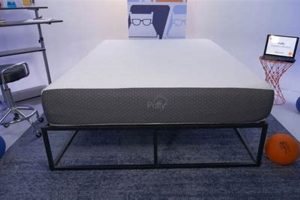
![Choosing Innerspring vs Memory Foam Mattress? [Guide] Organic & Natural Mattress Buyer’s Guide: Non-Toxic Sleep Solutions Choosing Innerspring vs Memory Foam Mattress? [Guide] | Organic & Natural Mattress Buyer’s Guide: Non-Toxic Sleep Solutions](https://mattressworldpa.com/wp-content/uploads/2025/07/th-1100-300x200.jpg)
